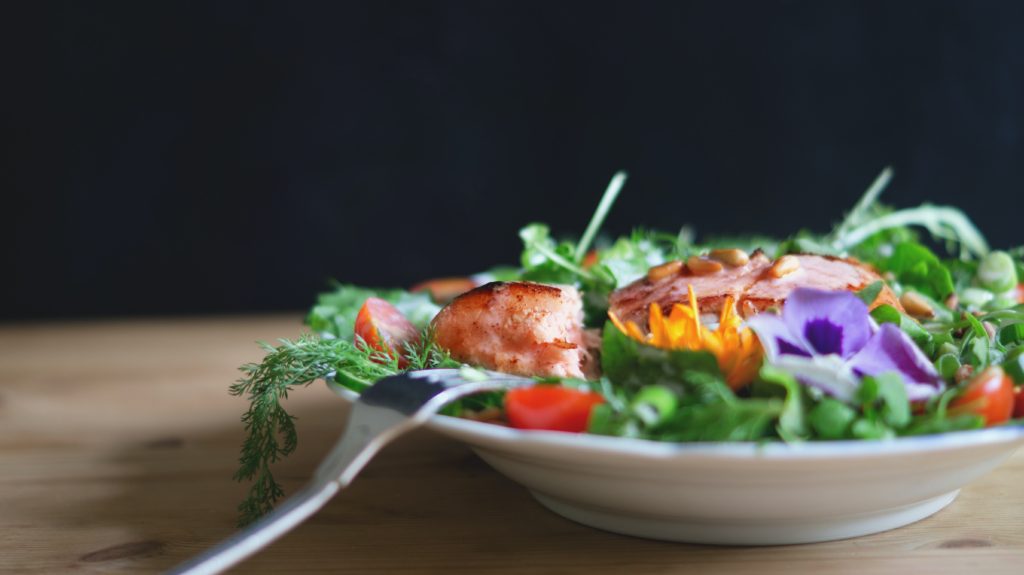8 Eating Habits of Lean People

Mostly eat natural, nutrient-dense whole foods
By natural, nutrient-dense whole foods, I mean foods like chicken breast, salmon, grass-fed ground beef, whole eggs, potatoes, sweet potatoes, rice, quinoa, oats, fruits and vegetables, and nuts and seeds. These are high-quality, whole foods packed with nutrients which help fuel your body.
Whole foods refers to food that has been refined or processed as little as possible and doesn’t contain additives or other artificial substances. These nutrient-dense, whole foods are often much more filling. They provide a lot of nutritional value, more volume, but for less calories.
Foods like beans, whole grains, fruits, and vegetables will contain more fiber. Fiber expands in your stomach when water is present, and delays gastric emptying. This helps you stay full for longer between meals. Eating those types of foods will make it easier to keep your calories down, and stay leaner.
On the other hand, you have highly processed, refined, and calorie-dense foods that lack nutritional value. Foods like cakes, cookies, ice cream, potato chips, many frozen dinners, most breakfast cereals, sweets, cakes, pies, other pastries, and processed meats are some examples.
Those foods are hyperpalatable, meaning a near perfect combination of fat, sugar, salt, and sometimes even a satisfying texture. They taste so good, and are so pleasing to eat, it’s hard to stop eating them. Combine that with the fact they’re calorie-dense and highly processed, and it’s very easy to get in more than enough calories and put on unwanted weight.
So, if you want to get lean and stay lean, make sure the large majority of your diet consists of natural foods that are rich in nutrients and provide quality fuel for your body. There’s room for less nutritious foods too, but they shouldn’t make up the bulk of your diet.
More home cooked meals
Those that maintain a lean physique eat the large majority of their meals at home. When you’re cooking at home, you control what goes into your meal. You know the amount of calories and macronutrients, and you can customize the meal to fit your preferences and calorie needs.
Home cooked meals are often lower in calories. When you go out to eat, they don’t care about the number of calories in a meal. They’re going to do whatever it takes to make the meal so tasty that you coming back for more. Most restaurants will use lots of oils and sauces that are very difficult to track. They often use fattier cuts of meat that are higher in calories because the fat content makes the meat tastier and juicer.
It’s easy to underestimate the number of calories in a meal when dining out, and I can guarantee there are more calories in the meal than what’s posted on the menu. When you decide what goes into your meals, and you know exactly how much you’re eating, it’s much easier to control your calorie intake.
This doesn’t mean never dine out. Most people can go out once a week, still make great choices, and stay on track. When you do go out to eat, be conscious of your food and drink choices, and know when to splurge and when not to.
Similar meals day-to-day
When you keep most of your meals very similar each day, it makes being consistent much easier. Consistency is a huge part of getting and maintaining the body you want.
Not only does it keep you consistent, but certain meals become routine. You may even begin to memorize the calorie content of the meal, or eventually don’t even have to measure out your food for a specific meal because you make it so frequently.
Planning ahead becomes easier, and the amount of decisions you have to make when grocery shopping becomes less and less. Your grocery trips become automatic, and you get very similar foods each trip.
I’m not saying never have variety, but it helps to keep the base of your meal constant, and vary the smaller details of the meal.
Here are some examples.
If your breakfast is egg whites, oats, and blueberries, every few days or each week you could change the fruit in your oats. After blueberries, you switch to chopped apples, then it’s a sliced banana, then strawberries. But the main part of your meal, the egg whites and oats, will remain the same for a while.
If your next meal is chicken breast, rice, and broccoli, you could switch up the vegetables every few days or each week, or swap potatoes for rice.
Before bed you might have Greek yogurt with whey protein and peanut butter. You could swap Greek yogurt for cottage cheese, keep the whey, and switch from peanut butter to sunflower seed butter, or mixed nuts.
For most people, this approach of keeping meals similar day-to-day helps simplify things, and makes being consistent easier. Find meals you really enjoy, and consistently eat them. Vary the smaller details of the meal, and find substitutes of certain parts of the meal that are similar in calories.
Plenty of protein and fiber
Protein helps build and maintain muscle. It also has the highest thermic effect of food, meaning your body burns more calories digesting and absorbing protein, than it does fats and carbohydrates. This is part of the reason protein intake should increase when the goal is to get lean and stay lean.
Protein is also more filling than most fats and carbohydrates. If you’re more satisfied and full after a meal, it’ll be easier to control your calories.
Fruits, vegetables, beans, lentils, brown rice, oats, and quinoa are some great sources of fiber. Fiber keeps you full for longer, making it easier to keep your calories down. Fiber also has lots of health benefits like controlling blood sugar, lowering cholesterol, maintaining healthy bowel movements, and more.
Also, notice many of those high fiber foods are also carbohydrates. Carbs are very important for fueling and recovering from hard training sessions. If the quality of your training improves, and you’re building more muscle, you’ll likely have an easier time staying leaner, assuming your diet is in order too.
Mostly low-calorie, high-volume foods
This goes back to my first point of eating more nutrient-dense, whole foods. Many of these foods are also lower in calories, but for more volume. More volume meaning they take up more space both on your plate, and in your stomach.
Think about 8 oz. of chicken breast. That’s a good amount of chicken that will take up a considerable amount of room on your plate. Eight ounces of chicken breast has approximately 240 calories.
Now imagine a large chocolate chip cookie on a plate. That won’t take up very much room at all, but still might be roughly 240 calories, probably even more. It’s also not going to be very filling, and you could probably eat 4 of them in one sitting, easily adding up to nearly 1,000 calories.
Vegetables are another example of very high-volume, low-calorie foods. You could eat 10 cups (extreme example, I know) of spinach for only about 100-150 calories. That’s going to take way more room in a bowl than a candy bar. There are about 215 calories in the typical Snickers bar. What do you think will be more filling? A Snickers bar, or 10 cups of spinach?
My point is, high-volume, low-calorie foods make eating less calories much easier. If you can control you calorie intake and eat less, getting and keeping the lean body you want is easier.
Flexibility
Those who comfortably maintain a lean physique rarely label foods as “good” and “bad.” Nothing is completely off limits, and anything in moderation is fine. They understand that you don’t need to be perfect, but you do need to be consistent.
They’re flexible in their approach to nutrition. They know how to handle traveling, vacations, and eating out, without completely falling off track.
When you’re flexible in your approach, you can successfully handle nearly any situation you’re thrown into, and know how to go out and eat what you enjoy and still stay the course. This makes getting and staying less a bit easier.
Following the 80/20 rule is a good idea. This means 80% or more of your diet consists of nutrient-rich, natural whole foods. The other 20% or less consists of less nutritious foods.
Less nutritious foods that are typically labeled as “bad” or “junk” can be eaten here and there, but be aware of your portion sizes and how it fits into your calorie budget.
Limit snacking
If you want to keep a leaner look, skip the snacking. Sit down, have a nice meal, and enjoy it.
Snacking is usually done out of boredom or to keep you busy as you watch TV, or maybe study.
Snacking is usually distracted eating. You’re on autopilot, grabbing and eating whatever is there and not truly enjoying it. It’s mindless eating that often results in consuming way more calories than you thought.
I once had someone ask me what they should eat while studying. I told them nothing. Don’t eat while you’re studying. You will most likely eat far more calories than you meant to. Instead, eat a meal before and after.
Besides that, many people underestimate the amount of calories they consume from all of the snacking and grazing they do throughout the day.
I’m not saying never have a small snack, but do your best to plan the snack, and have most of your eating throughout the day consist of actual meals. They’ll be much more enjoyable, you’ll feel more satisfied, and controlling your calorie intake will be easier.
Eating mindfully
Eating mindfully helps you enjoy the meal more. You’ll become much more aware of hunger signals, and your digestion will likely improve as you take your time, stop rushing meals, and chew your food more. Better digestion means better absorption. When your food is getting digested and absorbed better, your body can make better use of the nutrients you’re taking in.
If you’re more aware of hunger signals, you’ll know when to stop eating, and avoid unnecessary overeating. When you know roughly how much food it takes for you to be about 80% full, you can plan future meals a bit better so you’re eating portion sizes that work for you. You’ll be less likely to overeat, and have an easier time controlling your calories.
When you eat more mindfully, you avoid eating too fast. When you eat too fast, the signal that tells your body you’re full may not arrive until you’ve already eaten too much. This is common when people binge eat, and not so common in those that are leaner year-round.
Be mindful at all times, even when you eat and enjoy your meal.
